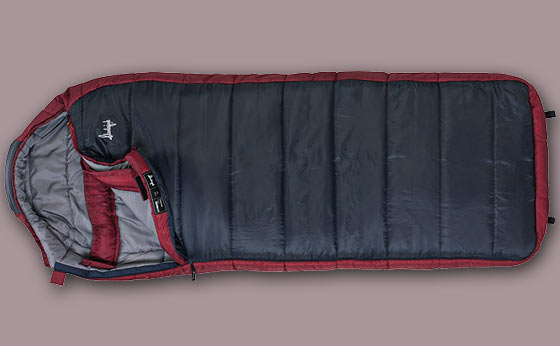Survival Kit Sleeping Bag

A sleeping bag provides shelter. One of the great risks during a survival situation is developing hypothermia – a condition where your body core temperature drops dangerously low – and it can happen in the summer, and any other season.
The right sleeping bag will virtually prevent hypothermia, a condition that can kill you quicker than you may think. Having only a blanket (for warmth-shelter) in your survival kit or bug-out bag may not be enough…
A sleeping bag however will provide insulation and some protection from the elements in a cocoon of warmth, trapped by your own body heat.
If you keep a 72-hour kit in your vehicle, even during the summer months consider also keeping a sleeping bag. Hypothermia is still a risk even during summer under certain conditions. In many places during the summer it still gets cold enough at night to bring on hypothermia, especially if you get wet.
If you get stranded in a vehicle when it’s cool or cold outside, crawling inside of a sleeping bag while inside the vehicle will be warmer than wrapping in a blanket.
If you have to walk out of a situation, having a sleeping bag (and the rest of your kit gear) will enable higher chances of survival if you have to shelter at night.
What is the best sleeping bag for a survival kit?
The best sleeping bag will be the one that you actually add to your kit, because any sleeping bag is better than none. Having said that, there are only a few main criteria to consider…
Sleeping bag temperature rating
Unless you plan on purposely camping or backpacking during the winter, a sleeping bag rating down to ‘freezing’ would be okay for many or most ordinary situations. However if you do live in a location where temperatures drop below freezing, a lower temperature rating would obviously be better. Or one for a warmer season and another for winter.
Point being, if the purpose for this sleeping bag is for your 72-hour survival kit to be kept in your vehicle (for example), consider the worst-case scenario for the environment that you may be in – and choose the sleeping bag temperature rating accordingly.
Temperature rating: WORD OF CAUTION… temperature ratings are often a survivability rating rather than a comfort rating. For a comfort rating a rule-of-thumb is to add 20 degrees. For example a sleeping bag (survivability) rating of 20-degrees-F would be more like a 40-degree bag for actual comfort. Check with the manufacturer…
Sleeping bag size, shape, and weight
Sleeping bag shapes are either the traditional rectangle shape or the mummy shape bag.
The rectangular bag allows for comfortable movement but is not as efficient at trapping your body heat. They are bigger, heavier, and will not roll up or fit in a ‘stuff-sack’ as small as a mummy bag.
The mummy bag is very good at trapping body heat and are predominately the colder rated bags. There are some very light weight mummy style sleeping bags, some which can roll up (or stuff) small and strap to a backpack, etc.
Be aware that sleeping bag dimensions vary, and for you big and tall folks, this is an important consideration. Be sure that you can fit comfortably inside.
Sleeping bag materials
The comfort of a sleeping bag will depend not only on temperature, but the softness of the inside shell and cushion of the insulation material, etc.
The outside shell material is also very important for durability and weather conditions – especially if considering outdoor use because you will want it to be waterproof or water-resistant as best as possible.
There are a tremendous number of sleeping bags available out there with a variety of features, quality choices, and price ranges.
Here’s one example of a popular ultralight mummy sleeping bag which is well suited for packing into a small space.
Please share your experiences with sleeping bags (and your tips or recommendations).
